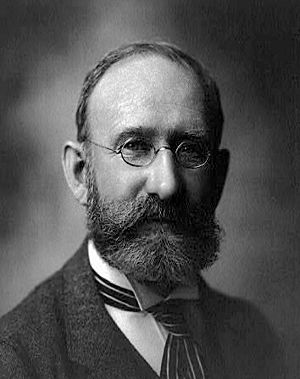Henry Henshaw facts for kids
Quick facts for kids
Henry Wetherbee Henshaw
|
|
|---|---|

Henshaw in 1904
|
|
| Born | March 3, 1850 |
| Died | August 1, 1930 (aged 80) |
| Education | Cambridge High School |
| Occupation | Ornithologist |
| Employer | U.S. Biological Survey |
| Known for | Co-founding the National Geographic Society, Wildlife Conservation in Hawaii |
Henry Wetherbee Henshaw (born March 3, 1850 – died August 1, 1930) was an American scientist. He was an ornithologist, which means he studied birds. He was also an ethnologist, someone who studies different cultures and peoples.
Henry Henshaw worked for the U.S. Bureau of Ethnology from 1888 to 1892. He also helped edit a science magazine called American Anthropologist.
Contents
A Life of Discovery
Early Adventures
Henry Henshaw was born in Cambridgeport, Massachusetts. When he was a teenager, he had to leave school because he was sick. To get better, he went on a trip to Louisiana to collect natural specimens. This trip started his exciting career as a field naturalist. A naturalist is someone who studies nature, especially plants and animals.
In 1870, Henry traveled to Florida with other naturalists. That same year, he made an important discovery in Boston. He found the first Baird's sandpiper bird ever seen east of the Mississippi River. This discovery made him known to Spencer Baird, a leader at the Smithsonian Institution.
Exploring the American West
In 1872, Henry Henshaw joined the Wheeler Survey. This was a big expedition that explored the western parts of the United States. He worked as a naturalist, studying and collecting information about nature.
His most successful trip was in 1874. He traveled from Santa Fe, New Mexico to the Gila River in Arizona. There, he met with the native Apache people. He also collected many animal specimens for the Smithsonian.
Later, he joined the United States Geological Survey. On this trip, he didn't just study birds. He also learned about different languages and cultures. He even helped write a two-volume book called Handbook of North American Indians North of Mexico.
Discovering Hawaii's Birds
In 1894, Henry Henshaw became very sick. He moved to Hawaii because he hoped the warm climate would help him get better. While he was there, he started taking pictures.
As his health improved, he went back to studying birds. He focused on the birds around Hilo, where he lived. He also studied birds in the drier, higher areas near Mauna Kea. He collected and saved hundreds of bird specimens. He also wrote two books about Hawaiian birds.
Seeing so many birds disappearing in Hawaii made Henry Henshaw care deeply about protecting nature. This experience turned him into a conservationist. He left Hawaii in 1904 and returned to Washington, D.C.
Working for Conservation
In 1910, Henry Henshaw became the head of the U.S. Biological Survey. This was a government agency that studied wildlife. He became very passionate about protecting birds.
In 1913, he published a book called Fifty Common Birds of Farm and Orchard. This book was very popular and sold 200,000 copies! The National Geographic Society asked if they could print parts of his book in their magazine. This led to the creation of the National Geographic Field Guide to Birds of North America.
Henry Henshaw also worked hard to pass new laws to protect birds. He helped George Shiras lobby for the Weeks-McLean Act. This law is also known as the Migratory Bird Law. In 1913, Henry Henshaw even handed President Woodrow Wilson the pen he used to sign the law.
Later Years
Henry Henshaw retired in 1916. He lived in Washington, D.C. and never married. In his older years, he started studying algae, which are simple plant-like organisms. He passed away on August 1, 1930, when he was 81 years old.
Important Groups He Helped Start
Henry Henshaw helped start several important organizations:
- The Nuttall Ornithological Club in 1873.
- The American Ornithologists' Union in 1883.
- The National Geographic Society in 1888.
His Legacy
Henry Henshaw is remembered in the scientific name of a type of lizard. It is called Xantusia henshawi.

